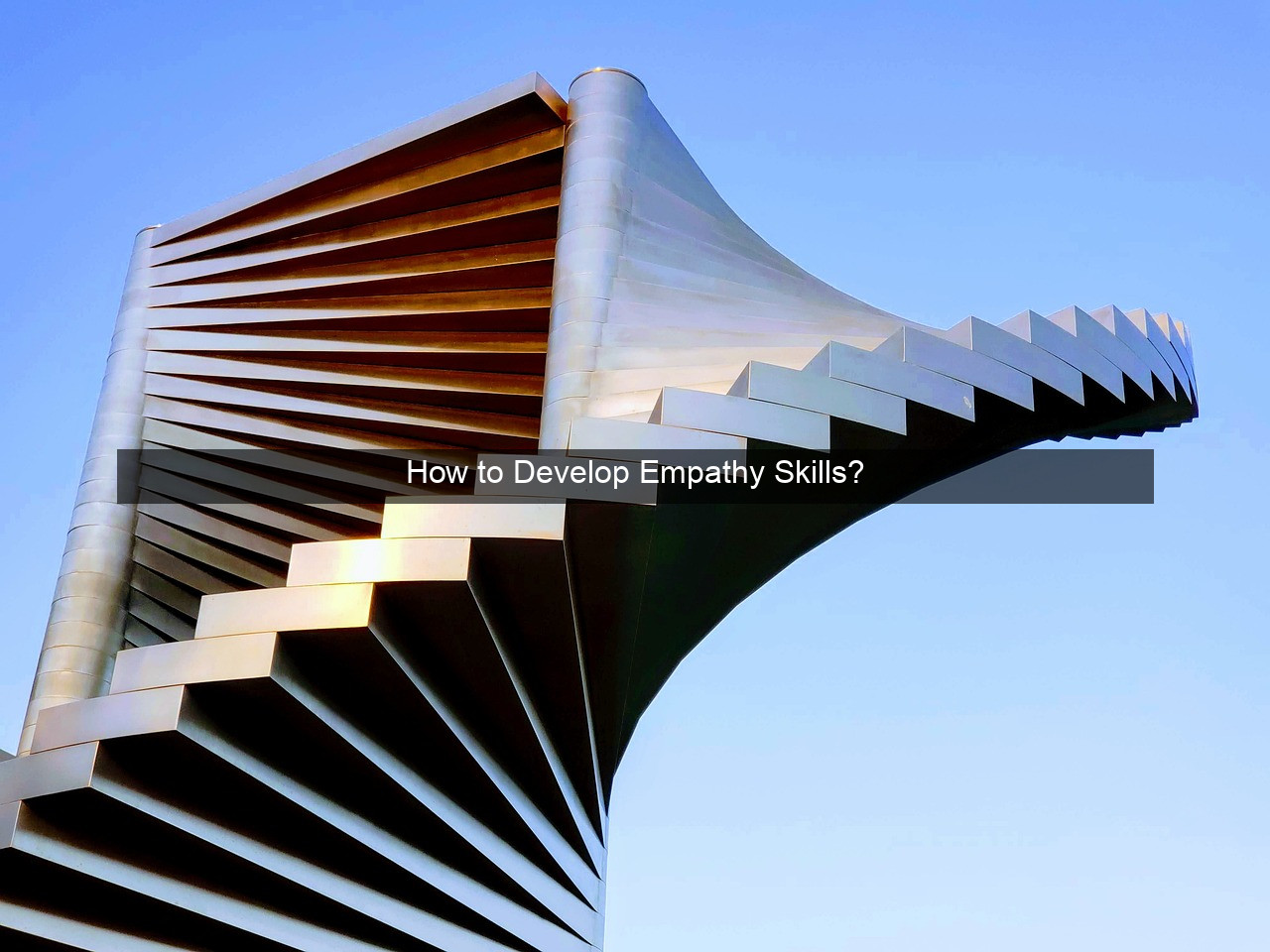How to Develop Empathy Skills?

- How to Develop Empathy Skills?
- Developing Empathy: A Guide to Understanding Others
- Understanding the Building Blocks of Empathy
- Cognitive Empathy: Understanding Perspectives
- Emotional Empathy: Sharing Feelings
- Compassionate Empathy: Taking Action
- Practicing Empathy in Everyday Life
- Active Listening and Communication
- Building Relationships Through Empathy
- Navigating Conflict with Empathy
- Cultivating Empathy Through Self-Reflection
- Journaling and Mindfulness
- Conclusion

Developing Empathy: A Guide to Understanding Others
In today’s increasingly interconnected world, empathy stands as a crucial skill for navigating social landscapes and building meaningful relationships. Empathy, the ability to understand and share the feelings of another, goes beyond simple sympathy. It involves stepping into someone else’s shoes and experiencing the world from their perspective. Developing strong empathy skills can transform your personal and professional life, fostering deeper connections, improving communication, and enhancing conflict resolution. This comprehensive guide will explore practical strategies and techniques to cultivate and strengthen your capacity for empathy.

Understanding the Building Blocks of Empathy
Cognitive Empathy: Understanding Perspectives
Cognitive empathy involves understanding another person’s perspective, even if you don’t necessarily share their feelings. It’s about recognizing their thoughts, beliefs, and motivations. This intellectual understanding forms the foundation for building a deeper emotional connection. Developing cognitive empathy requires active listening and a genuine curiosity about others’ experiences.
Actively listen to what others are saying, both verbally and nonverbally. Pay attention to their body language, tone of voice, and facial expressions. Ask clarifying questions to ensure you understand their viewpoint. Challenge your own assumptions and biases. Recognize that your experiences shape your perspective, and others may have vastly different experiences.
Practice perspective-taking by imagining yourself in someone else’s situation. Consider their background, values, and current circumstances. This mental exercise can broaden your understanding and challenge your preconceived notions.
Emotional Empathy: Sharing Feelings
Emotional empathy involves sharing the feelings of another person. It’s about experiencing their joy, sadness, anger, or fear as if it were your own. This emotional resonance strengthens bonds and fosters a sense of shared humanity. Developing emotional empathy requires vulnerability and a willingness to connect with your own emotions.
Pay attention to your own emotional responses. By becoming more aware of your own feelings, you can better recognize and understand the emotions of others. Practice mindfulness and emotional regulation techniques. This will help you manage your own emotional responses and create space for empathy.
Engage in activities that expose you to diverse perspectives, such as reading literature, watching films, or listening to music from different cultures. This can broaden your emotional range and enhance your ability to connect with others’ feelings.
Compassionate Empathy: Taking Action
Compassionate empathy goes beyond understanding and sharing feelings. It involves taking action to alleviate another person’s suffering. This active form of empathy can manifest in various ways, from offering practical support to advocating for social justice. Cultivating compassionate empathy requires a sense of responsibility and a commitment to making a positive impact.
Identify opportunities to help others, whether it’s a small act of kindness or a larger commitment to a cause. Volunteer your time or resources to support organizations that align with your values. Speak out against injustice and advocate for those who are marginalized or oppressed.
Practice self-compassion. Recognizing your own limitations and imperfections can make you more understanding and compassionate towards others.
Practicing Empathy in Everyday Life
Active Listening and Communication
Active listening is a cornerstone of empathetic communication. It involves fully focusing on the speaker, understanding their message, and responding thoughtfully. This creates a space for genuine connection and fosters mutual understanding. Practice reflecting back what you hear to ensure you’ve understood correctly.
Ask open-ended questions to encourage the speaker to elaborate on their thoughts and feelings. Avoid interrupting or offering unsolicited advice. Pay attention to nonverbal cues, such as body language and tone of voice. These can provide valuable insights into the speaker’s emotional state.
Validate the speaker’s feelings, even if you don’t necessarily agree with their perspective. This shows that you respect their experience and value their input.
Building Relationships Through Empathy
Empathy is the glue that holds relationships together. It allows us to connect with others on a deeper level, build trust, and navigate conflicts effectively. Practice showing genuine interest in others. Ask about their lives, their interests, and their experiences.
Celebrate their successes and offer support during challenging times. Be present and engaged when interacting with others. Put away distractions and focus on the conversation at hand.
Practice forgiveness. Holding onto resentment can erode empathy and damage relationships. Letting go of grudges can create space for healing and reconciliation.
Navigating Conflict with Empathy
Empathy can be a powerful tool for resolving conflicts constructively. By understanding the other person’s perspective, you can find common ground and work towards mutually acceptable solutions. Try to see the situation from the other person’s point of view. Consider their needs, their motivations, and their fears.
Communicate your own perspective clearly and respectfully. Avoid blaming or accusatory language. Focus on finding solutions that address both your needs and the needs of the other person.
Be willing to compromise. Sometimes, finding a resolution requires both parties to make concessions. Empathy can help you see the bigger picture and prioritize the long-term health of the relationship.
Cultivating Empathy Through Self-Reflection
Journaling and Mindfulness
Journaling can be a powerful tool for developing self-awareness, which is a prerequisite for empathy. Reflecting on your own experiences and emotions can help you better understand the experiences of others. Regularly write about your thoughts, feelings, and interactions with others.
Practice mindfulness meditation. Paying attention to your present moment experience can enhance your emotional awareness and regulation, which are essential for empathy.
Reflect on your own biases and prejudices. Everyone has biases, and acknowledging them is the first step towards mitigating their impact on your interactions with others.
| Empathy Skill | Description | Example |
|---|---|---|
| Cognitive Empathy | Understanding another’s perspective | Recognizing a friend’s sadness after a loss |
| Emotional Empathy | Sharing another’s feelings | Feeling happy for a colleague’s promotion |
| Compassionate Empathy | Taking action to help | Volunteering at a homeless shelter |
- Practice active listening.
- Challenge your own assumptions.
- Engage in perspective-taking.
Conclusion
Developing empathy is a lifelong journey that requires conscious effort and practice. By cultivating cognitive, emotional, and compassionate empathy, you can transform your relationships, enhance your communication skills, and contribute to a more compassionate world. Embrace the challenges and rewards of this journey, and witness the positive impact empathy can have on your life and the lives of those around you.
What is empathy?
Empathy is the ability to understand and share the feelings of another person.
Why is empathy important?
Empathy is crucial for building strong relationships, improving communication, and resolving conflicts effectively.
How can I develop empathy?
You can develop empathy by practicing active listening, challenging your assumptions, engaging in perspective-taking, and cultivating self-awareness.
What are the different types of empathy?
The main types of empathy are cognitive empathy, emotional empathy, and compassionate empathy.
How can I practice empathy in everyday life?
You can practice empathy in everyday life by actively listening to others, showing genuine interest in their lives, and offering support during challenging times.



